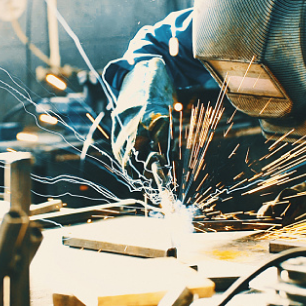Jump to:
Why Pipe Welding Quality Matters
Why does quality matter? Poor quality costs schedule, money, and harm to the industry’s reputation. Poor quality can also result in safety issues, potentially harming people and property. A project that is focused on production only is susceptible to quality issues. Poor quality happens when the practices outlined in this article are not followed.
Setting the Stage
Volumetric nondestructive examination (NDE) determines the integrity of a weld throughout the entire volume and not just the surfaces we can access. Welders are not unfamiliar with phased array ultrasonic testing (PAUT) and radiographic testing (RT), as these methods are used in various code applications. However, these methods have their strengths and weaknesses regarding the probability of detection and acceptance criteria. Project initiation training for the welders, fitters, and supervisors provides significant value. When the construction group is educated on how each method can detect and size defects, they can focus on mitigating issues that may not have been considered.
Welding and Flaw Types
Each welding process comes with its own unique challenges and flaw characteristics — Table 1. Understanding what type of discontinuities to expect from the welders helps to prevent them. Similarly, when the NDE technician understands the types of discontinuities typically found, their interpretations become more accurate. Welding process, joint configuration, weld location, and type and size of weld all help to determine the type of discontinuities to expect and the best method for their detection.
When welding with a flux-containing process, such as shielded metal arc welding or flux cored arc welding, slag is created. When the welder understands the importance of cleaning between the weld beads, they are more likely to take the extra time to remove the slag prior to depositing the next pass. When welding with gas tungsten arc welding (GTAW), we would not expect to find slag but tungsten inclusions and crater cracks.
The welders’ understanding of the importance of adhering to the welding procedure specification (WPS) preheat and interpass temperature requirements helps prevent hydrogen cracking. The cleanliness of the weld joint and the proper storage and handling of the filler materials also help prevent hydrogen cracking.
Typical NDE on Piping
American Society of Mechanical Engineers (ASME) B31.3, Process Piping, allows for two different methods of volumetric examination, RT and ultrasonic testing (UT). PAUT is not called out specifically as a requirement when used instead of RT; however, the encoded record of PAUT is highly beneficial in sizing and categorizing defects. The decision to use PAUT is often required by client specification, as this is best practice.
Arming the Welders for Success
It is critical that the training be delivered in a manner that is easily digestible and directly relatable to the piping welding scope of the project. Covering the details of the welding methods that will be used, how differing technologies work in a practical sense, and how the readouts of each technology are deciphered will provide the welding and construction team with the information to optimize the welding techniques that will be utilized.
Explaining the Code of Construction
Within ASME B31.3-2024, the primary table of interpretation is Table 341.3.2-1, Acceptance Criteria for Welds – Visual and Radiographic Examination. This table requires an understanding of a flaw type and is assessed based on the size of the flaw. Where specified, UT interpretation is described in paragraph 344.6.2 and Appendix R, Use of Alternative Ultrasonic Acceptance Criteria, for materials over 1 in. In 344.6.2, the flaw type is only categorized as linear or nonlinear. In Appendix R, fracture mechanics applies, and the flaws need not be categorized. In both cases for UT, the flaw type does not matter. Any indications found that exceed the described thresholds are grounds for failure. However, this is a disservice to construction. As mentioned above, flaws specific to each welding type are caused by different issues in the welding processes. PAUT is fully capable of determining flaw types based on echo dynamic characteristics. The position in the weld volume of these flaws can assist in pinpointing the issue — Fig. 1.
Full Cycle Information Gathering
It is essential to sit down with the welders after a reject and explain the position, morphology, and possible causes of specific flaws. Often, a welder will look at RT films or a PAUT scan and recall changing conditions or unfavorable fitups in the area where a rejection occurred.
Without this feedback loop and open dialogue, poor-quality welds continue without answers about why they are happening. Even before the examination occurs, it is critical for the NDE inspectors to know what welding processes were used during the weld.
Information Is Power
All piping projects have a budget and schedule. This is no secret. Investigative NDE costs time and money, but the information gained can be priceless. Some examples are using a UT method to determine the depth of a flaw found using RT or using RT to assist in flaw characterization in coarse-grained materials where UT may not have optimized clarity. Complementary investigation has driven procedural changes in piping projects where systemic issues required a sustainable solution. Without additional information, the welding and issues would continue. Example: Feedback and demonstration to the welder of a concave root in a GTAW root pass can mean that the backing gas purge was insufficient.
Conclusion
Education of front-line fitters and welders will improve reject rates, productivity, and overall weld quality. Open and transparent communication lines foster a homogeneous relationship that does not silo groups throughout the construction process. A key factor of success is ensuring a lead NDE inspector who can educate and support the construction activities.
ELIA DAMIS (elia.damis@fluor.com) is director of nondestructive testing at Fluor Corp., Edmonton, Alberta, Canada, and an ASNT ISO 9712 Level III. KIM JACKSON (kim.moody.jackson@fluor.com) is director of welding engineering at Fluor Corp., Greenville, S.C., and Edmonton, Alberta, Canada. She is an AWS CWI and ASNT Level III.


